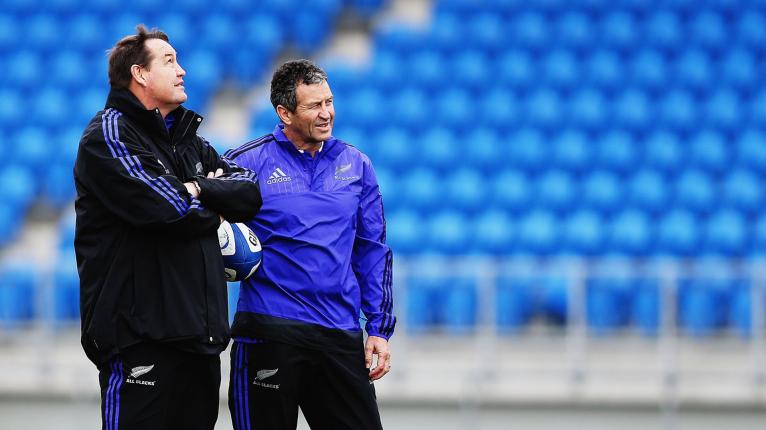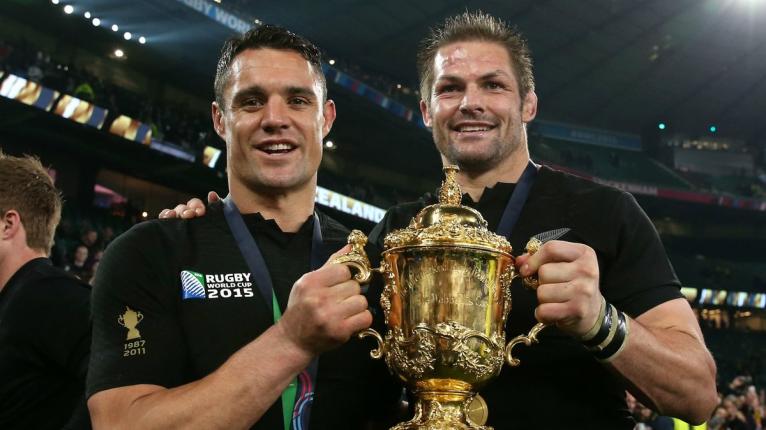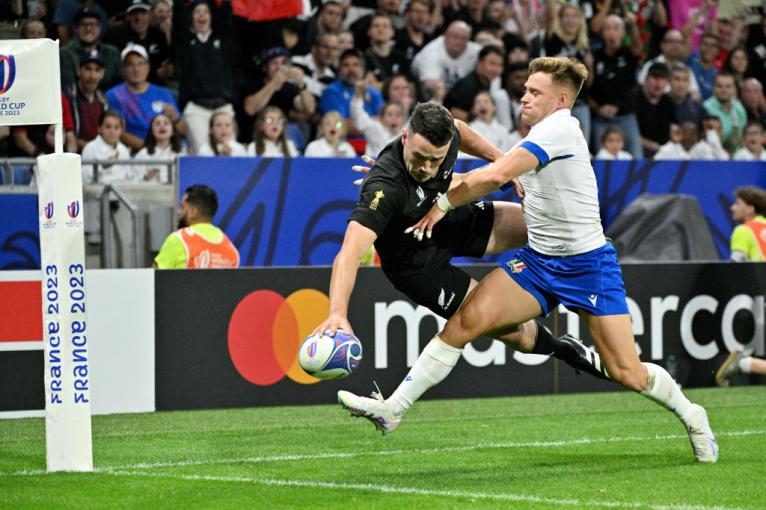Throughout 2014, former All Blacks coach Steve Hansen was willing to take a major risk. He decided to shift defence coach Aussie McLean to a new job analysing the opposition and he installed himself in the McLean’s vacant defence role.
Hansen juggled the two roles of head coach and defensive coordinator, which wasn’t ideal, but the All Blacks got through their 14-match season with 12 victories, one loss and one draw.
It wasn’t a sustainable set-up, however, not with the World Cup around the corner in 2015 – a tournament which Hansen felt his side would need to be at their defensive best if they were going to win it.
And this was why he had not filled the role with a new applicant in 2014. He was waiting for the man he wanted, and that man was his long-term friend and coaching partner, Wayne Smith, who was under contract with the Chiefs until the end of 2014.
It took all of Hansen’s persuasive powers, but in December 2014, he got his man and Smith signed up to be the All Blacks defence coach at the 2015 World Cup.

For Hansen, it was a pivotal moment. He says he would be lying if he knew then that the All Blacks were going to win the World Cup, but he certainly felt decidedly more confident about their chances of doing so in England once he knew that Smith was going to be building their defence strategy.
The All Blacks coach knew that his team would have to reinvent itself to some degree in 2015 – despite having lost just two Tests between 2012 and 2014 – and while he was going to tinker with their attack options, the big change at the World Cup was going to be the way the team defended.
Hansen, who had been at three previous World Cups – one with Wales, and two as an assistant coach with the All Blacks – knew the importance of defence in winning the tournament.
The statistics were undeniable that, typically, the team that won the World Cup would have a supremely good defensive record at the tournament.
In 1987, the All Blacks didn’t concede a try in the knock-out rounds and just 18 points were scored against them in the three games.
In 1991 Australia didn’t concede a try in either the semi-final or final – just two penalties were scored against them in each game, while in 1995 South Africa leaked just 26 points in the pool round and didn’t concede a try in either of their last two matches.
It was clear enough why Hansen wanted Smith, who he believed was the smartest thinker in the world game.
Australia famously won in 1999, conceding just one try in the whole tournament. England conceded only one try in their last two games in 2003 and South Africa conceded an average of just 12 points per game in 2007 and in 2011, New Zealand were even more miserly, conceding just 10 points per game on average.
So it was clear enough why Hansen wanted Smith, who he believed was the smartest thinker in the world game. Hansen wanted the man known as ‘The Professor’ to introduce an entire new way of defending at that tournament.
The first month the All Blacks were in England, they focused primarily on defence and not attack. They were flogged at training, asked to tackle, tackle and tackle again until Smith’s system was ingrained.
As Smith revealed in Hansen’s biography, Steve Hansen: The Legacy: “I like the structure of defence more than line speed and we had a unique system of counting in defence.
“I wanted us to always be marked up on people and I couldn’t accept the fact that you’d leave a space somewhere for them to attack, like out wide. We created a system where we had to have 14 men on our feet and what that allowed us to do was recognise the cues of when we should attack the ball.
“Once you did turn it over, you had most of your men on their feet ready to quickly counter-attack. Those were the fundamentals of it, but it was obviously a bit more complex.

“We worked really hard at making our chop tackles dominant and we brought in the ability for the inside man to get into the tackle. We had a guy making the chop tackle and then a second man coming in over his back to get four feet against two in the tackle and because we are not as big as some of the other teams like South Africa, that was the way we got dominance.”
The magic of the new system was not necessarily that it made the All Blacks impenetrable as they conceded a total of 97 points in that tournament – still the lowest of any side at the tournament when averaged out – but more than they had in 2011.
But the new system was actually about using their defence to create counter-attack opportunity, and this is what revolutionised the All Blacks.
Smith’s plan was perfect as by keeping players on their feet, the All Blacks were able to transition from defence to attack with incredible awareness and they scored a scarcely believable 116 points in the knock-out rounds.
The quality of their tackling enabled them to score almost an average of 40 points a game in the most intense part of the tournament and that’s why former Ireland international Ronan O’Gara was making such an astute point on Sky’s The Breakdown programme, when he questioned the quality of New Zealand’s defensive work over the last few years.
“I think where teams have probably gone beyond them is on the defensive side,” he said. “Their attack has always been top notch, but I think defensively it seems like they’re still defending the man, which nowadays, with teams’ capacity to retain the ball, is you keep pushing them towards the sideline.
As much as it was an attacking masterclass from the All Blacks in Lyon, so too did it illustrate the importance of their defence in being the foundation of that attack.
“The opposition is going to have too much possession and be able to fire too many shots and they probably have to defend a lot of players with X-factor.
“I think if they’re very aggressive with their defence, they could surprise people an go all the way.”
Interestingly, a few days after O’Gara made his comment, the All Blacks annihilated Italy 96-17 in what appeared to be a stunning show of attacking rugby.
But as much as it was an attacking masterclass from the All Blacks in Lyon, so too did it illustrate the importance of their defence in being the foundation of that attack.
It felt to some degree that the All Blacks wound the clock back to 2015 against Italy, opting to use the chop tackle more and have the second man hit higher to produce the four legs versus two that Smith was so keen on eight years ago.
So too were the All Blacks much more alive to defensive turnover opportunity – again a big part of their 2015 plan. The art of wining turnovers is picking the cues – of knowing when a dominant tackle may be coming, predicting it early and then reacting quickly.

From his vantage point on the wing, Will Jordan certainly felt that the way the All Blacks defended was a major factor in helping them score almost 100 points.
“Footy can be a simple game when you are going forward and the boys set a great platform both at set-piece and general around the park,” said Jordan.
“I thought defensively they were strong in the tight stuff. We saw a lot of dominant tackles that allowed us to go forward and get ruck turnovers and it was with turnover ball that we really started to turn it on. Obviously, the set piece was huge but defensively it was a great shift.
“It was definitely how we wanted to play but I am not sure that is how we pictured it. We knew their attack shape with their guys swinging around would challenge us and we saw that a lot, but we scrambled well and on attack it was our breakdown being huge that allowed us to flow into it.”
The All Blacks put the world on notice with the way they destroyed Italy, scoring 14 tries in the process.
It was a performance reminiscent of their quarterfinal destruction of France in 2015 – a performance that looked to be all about their attack yet was built on the aggression of their defence.
And maybe the bit that everyone has missed, is that in Lyon, the All Blacks quietly upped the aggression and accuracy of their tackling and turnover work, and it is the improvement in their defence which may end up being the key to their World Cup campaign.


Defense is attitude, culture of the team. And I'm sorry to say foster is not up to it .starts at the top . His track record is poor well before the top job. He's to nice and been there to long . It's showing in the team.roll on scotty
Let me get his straight - an 8 year old innovation by a long since gone coach is now the AB's current secret weapon? Sounds like you are getting a bit excited there Gregor. Certainly the most innovation in defense I've seen over that period has been from Farrell, going way back to the Lions in 2017 - the AB's have been struggling to impose their natural game on the best sides ever since. There were definitely some promising signs against Italy, but let's not overlook how poor the Italians were.
You mean since 2019 because 2017 NZ was so dominate in both attack and defense beating the Bok 57-0 also smith is now part of the all blacks squad and black ferns
A good example is watching Laulala attempts at tackling. Stick an arm out hoping (Sotutu style) and just see the player run past him. Rieko and BB both need to up their tackling or lack thereof as well.
Don't really understand the point of the article...of course Sir Wayne is much better than Mcleod (and Foster) but he is in NZ so it is not going to help the ABs in 2023....
Apparently they are going to dig out his strategy from 2015 and reuse it. As if the World hasn't changed since then..
Gregor Paul, who I love to read and would be the only reason I would subscribe to NZ Herald, usually locked up behind a paywall.
Please tell me you have access to all his material..😎
Why is Scott McLeod's passive defence strategy never mentioned? All Blacks have leaked an average 19pts per game since 2020. Japan, South Africa, France, Ireland, and Australia have all put 30+ points on NZ over that time.
So true, the inconvenient facts. Our friend Gregor gets a bit nostalgic sometimes.
True story, this defence does nothing but invite pressure and all the big nations do is run at the AB's with a two man maul like system which makes it impossible to attack the breakdown.
Clearly worst defense coach . It can cost us vs Ireland !
Geez I normally enjoy Gregor Paul's articles but this one ignores the fact that the All Blacks back row of 2015 was far superior at all 3 positions (especially as defenders) than the 2023 team.
There is not one aspect of openside flanker play that Sam Cane or Dalton Papali'i is as good at as even a 34 year old Richie McCaw, ESPECIALLY jackling.
Jerome Kaino was so much better at blindside flanker than Shannon Frizell its laughable. Only in two tests matches (vs Springboks in 2022 and 2023) has Frizell matched Kaino's physicality. Frizell has never dominated two tests in a row.
While Ardie Savea at #8 may be Kieran Read's equal at jackling (both very good), Read was a far more dominant and bruising tackler (and ball carrier).
Wayne Smith's system worked when he had 3 truly world class back row forwards at his disposal. The All Blacks currently have 1 world class player (Savea obviously) and two average test level back rowers. Not too sure a passive defensive system is going to work with this lot.
Playing loose is not all about the jackal buddy. And McCaw was a freak. Sometimes a tackle just feels right and three good hits is all it takes to cause a knock-on or a lose pass, a messy set, little moment of hesitation, that's what domination looks like. Would you like to be tackled by Dalton, Sam or Shannon three times quickly? Blackadder is the closest we have to MCCaw, everywhere all at once all the time - half mad. Jacobson is both an excellent jackal and hitter but clearly on ice to cover serious injury to Ardie. Our loose men are awesome. And just starting to hunt as a pack
Yes, it's easy to look at the past and say how much better the All Blacks back row was in 2015. However, is it really because they were better than the 2023 back row because the opposing teams are now a hell of lot better than they were in 2015? It's taken longer than I thought it would after the game went professional, but the northern teams with greater player numbers, money etc are now a lot more powerful, so dominating against them is so much more difficult.
I'm also not too sure about your assessment of Kieran Read's dominance. His team were pummeled by England in the 2019 semi final.
The whole system of defence now depends on all players at the breakdown dominating/jackling, not just the backrow. That's certainly where Ireland has excelled ironically with guys like James Lowe who looks small but is actually quite big and has learnt a thing or two since moving the Ireland.
Wayne would work magic with the current forwards too (Cane was also there in 2015) but the defense coach is McLeod! FYI Papalii has not gotten any penalty or steal in the first 3 games
He is specifically talking about the 2015 defensive structures....when they had those players at their disposal and that Saturdays game was reminiscent of it.
That loose forward trio will go down in history as one of, if not the best ever.
Worth noting that other teams defend differently to the AB’s e.g. SA and France, and both have beaten by Ireland. AB’s attack and defend differently which could be a key point if difference. AB’s would’ve won that last game against Ireland if they could defend a maul and were more creative in attack, there defence against general phase play wasn’t all that bad.